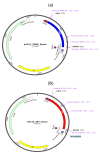Standardization of a Sex-Sorting Protocol for Stallion Spermatozoa by Means of Absolute RT-qPCR
- PMID: 37569324
- PMCID: PMC10419253
- DOI: 10.3390/ijms241511947
Standardization of a Sex-Sorting Protocol for Stallion Spermatozoa by Means of Absolute RT-qPCR
Abstract
Sperm sexing is a technology that can generate great economic benefits in the animal production sector. Techniques such as sex-sorting promise over 90% accuracy in sperm sexing. However, for the correct standardization of the technique, some laboratory methodologies are required. The present manuscript describes in detail a standardized equine sperm sex-sorting protocol using an absolute qPCR-based methodology. Furthermore, the results of absolute qPCR were implemented and validated by generating equine/bovine heterologous embryos by intracytoplasmic sperm injection (ICSI) of presumably sexed equine spermatozoa into bovine oocytes using a piezoelectric system (Piezo-ICSI). Our results indicated that equine sex-sorting spermatozoa had a 97% and 94% certainty for X and Y sperm, respectively, while presumptive female and male equine/bovine hybrid embryos, generated by Piezo-ICSI, had an accuracy of 92% with respect to the desired sex. Therefore, it is concluded that the presented methodology is a reliable, cost-effective, and relatively simple option for standardizing sex-sorting of equine spermatozoa. This is supported by the results of the correct sexing of Piezo-ICSI heterologous embryos generated with the sexed spermatozoa, validating the correct sexing and viability of these gametes.
Keywords: PIEZO-ICSI; absolute RT-qPCR; plasmids; sex-sorting; sperm stallion.
Conflict of interest statement
The authors declare no conflict of interest.
Figures







Similar articles
-
Developmental competence in vivo and in vitro of in vitro-matured equine oocytes fertilized by intracytoplasmic sperm injection with fresh or frozen-thawed spermatozoa.Reproduction. 2002 Mar;123(3):455-65. Reproduction. 2002. PMID: 11882023
-
Intracytoplasmic sperm injection of bovine oocytes with stallion spermatozoa.Theriogenology. 2003 Mar;59(5-6):1143-55. doi: 10.1016/s0093-691x(02)01179-2. Theriogenology. 2003. PMID: 12527063
-
Sperm factors associated with the production of equine blastocysts by intracytoplasmic sperm injection (ICSI) using frozen/thawed semen.Theriogenology. 2023 Jan 1;195:85-92. doi: 10.1016/j.theriogenology.2022.10.014. Epub 2022 Oct 17. Theriogenology. 2023. PMID: 36332376
-
Bovine ICSI: limiting factors, strategies to improve its efficiency and alternative approaches.Zygote. 2022 Dec;30(6):749-767. doi: 10.1017/S0967199422000296. Epub 2022 Sep 9. Zygote. 2022. PMID: 36082429 Review.
-
Current Reproductive Technologies Impacting Equine Embryo Production.J Equine Vet Sci. 2020 Jun;89:102981. doi: 10.1016/j.jevs.2020.102981. Epub 2020 Mar 12. J Equine Vet Sci. 2020. PMID: 32563442 Review.
Cited by
-
The impact of induced pluripotent stem cells in animal conservation.Vet Res Commun. 2024 Apr;48(2):649-663. doi: 10.1007/s11259-024-10294-3. Epub 2024 Jan 16. Vet Res Commun. 2024. PMID: 38228922 Review.
-
Molecular Mechanisms Involved in Sperm Development, Maturation, and Fertilization.Int J Mol Sci. 2025 Apr 25;26(9):4049. doi: 10.3390/ijms26094049. Int J Mol Sci. 2025. PMID: 40362289 Free PMC article.
References
MeSH terms
Grants and funding
LinkOut - more resources
Full Text Sources

